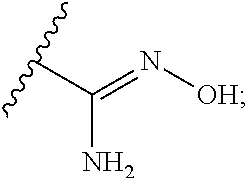Small molecules as epigenetic modulators of lysine-specific demethylase 1 and methods of treating disorders
a lysine-specific demethylase and small molecule technology, applied in the field of small molecule compounds, can solve the problems of increasing the risk of unfavourable side effects and mao of lsd1 inhibitors, and achieve the effect of inhibiting or reducing lysine-specific demethylase 1
- Summary
- Abstract
- Description
- Claims
- Application Information
AI Technical Summary
Benefits of technology
Problems solved by technology
Method used
Image
Examples
example 1
Synthesis of
[0329]
[0330]Cyanoacetic acid (0.96 g, 11.1 mmol, 1 eq) was added to a mixture of PCl5 (2.35 g, 11.1 mmol, 1 eq) in 200 mL of CH2Cl2, and the mixture refluxed for 30 minutes. After cooling, aniline (1.01 mL, 1.03 g, 11.1 mmol) was added and the solution was refluxed for 2 hrs. The reaction mixture was allowed to cool to room temperature, and then concentrated to dryness at the rotary evaporator. A 50 mL portion of water was added and the suspension was filtered. The resulting solid was then washed with 25 mL of 1.0 N NaHCO3 solution, 25 mL of water and then dried to afford the desired cyanoamide as a white amorphous solid (1.64 g, 92%). This solid was of sufficient purity to be used without further purification in the subsequent reaction. 1H NMR (400 MHz, acetone-d6) δ 9.58 (s, 1H), 7.62 (d, J=8.4 Hz, 2H), 7.33 (t, J=8.0 Hz, 2H), 7.11 (t, J=7.2 Hz, 1H), 3.82 (s, 2H).
[0331]A 0.9 g portion (12.8 mmol, 1.25 eq) of NH2OH.HCl was added to Na2CO3 (1.36 g, 12.8 mmol, 1.25 eq) di...
example 2
Synthesis of
[0332]
[0333]A mixture of 5.0 g (16.8 mmol) of N-(5-bromopentyl)phthalimide (n=4) and 1.41 g (18.5 mmol) of thiourea was heated at reflux in 10 ml of absolute ethanol (EtOH) for 18 h. The mixture was cooled to room temperature, and the product was collected by filtration and then washed with two 10-ml portions of chilled EtOH and four 15-ml portions of acetone and dried under vacuum. The product was obtained as a colorless solid: yield 5.62 g (90%); mp 188 to 190° C. 1H NMR (400 mHz, DMSO-d6) δ 1.42 (m, 2H), 1.65 (m, 4H), 3.15 (t, 2H, J 7.2 Hz), 3.61 (t, 2H, J 6.9 Hz), 7.90 (m, 4H), and 8.97 (br s, 4H).
example 3
Synthesis of
[0334]
[0335]A solution of 1,3-diaminopropane (7.49 mL, 6.67 g, 100 mmol, 20 eq) and triethylamine (0.70 mL, 0.51 g, 5.0 mmol, 1 eq) in 40 mL of benzene was cooled to 10° C., and a 4-chloro-3,5-dinitrobenzotrifluoride in 40 mL of benzene was added dropwise over a period of 2 hours. The reaction was warmed to room temperaturte and allowed to stir overnight, after which it was concentrated in vacuo to yield an orange liquid. This residue was dissolved in 200 mL of ethyl acetate and the organic layer was washed with 2 25 mL portions of water and 25 mL of saturated aqueous NaCl. The ethyl acetate layer was dried over anhydrous MgSO4 and concentrated, and the crude mixture was purified by column chromatography using a solvent gradient (1:1 hexanes:ethyl acetate to ethyl acetate to 3:1 ethyl acetate:methanol). The desired fractions were pooled and concentrated to give an orange solid, which was dissolved in ethyl acetate. 1.0 M HCl in ethyl acetate was added slowly until no mor...
PUM
| Property | Measurement | Unit |
|---|---|---|
| Molar density | aaaaa | aaaaa |
| Molar density | aaaaa | aaaaa |
| Molar density | aaaaa | aaaaa |
Abstract
Description
Claims
Application Information
 Login to View More
Login to View More - R&D
- Intellectual Property
- Life Sciences
- Materials
- Tech Scout
- Unparalleled Data Quality
- Higher Quality Content
- 60% Fewer Hallucinations
Browse by: Latest US Patents, China's latest patents, Technical Efficacy Thesaurus, Application Domain, Technology Topic, Popular Technical Reports.
© 2025 PatSnap. All rights reserved.Legal|Privacy policy|Modern Slavery Act Transparency Statement|Sitemap|About US| Contact US: help@patsnap.com



